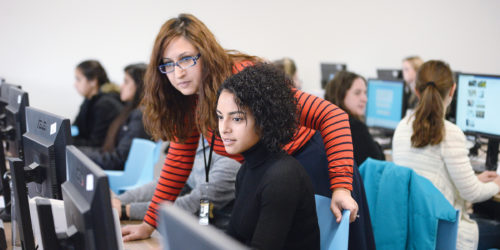
Best Practices to Teaching the Second Half of an Asynchronous Course
In this Hub post, we will explore specific strategies and key considerations for effectively teaching the second half of an asynchronous course.
Let’s set the stage: you’ve been assigned to take over an asynchronous course midway through the semester, starting at Week 9. You may be asking yourself what steps you can take to ensure a smooth transition from one faculty member to another that best supports student success. This hub post will suggest some factors you may want to consider when aligning your work in the second half of the semester with the asynchronous course’s existing structure, content, and student needs.
Considerations
Professor Introduction
Just as you would at the start of a full course, take the opportunity to introduce yourself to your class. Create a dedicated “Meet the Professor” page that is separate from that of the previous faculty member, aimed at helping students get to know you. Consider including a short video introduction to make a more personal connection and begin building rapport with your learners. Use this space to outline your approach to teaching the course, describe how you will support students in their asynchronous learning, and set expectations for what they can expect from you throughout the remainder of the term. Also, give thought as to what your “Instructor Presence” looks like in the course for the second half of the semester. Explore the resources on 7 Steps to Being “Present” as an Asynchronous Online Teacher and Share About You.
Content Review
One of the cornerstones of facilitating an asynchronous course is ensuring that all learning materials are fully prepared and accessible to students. As you take over the second half of the course, conduct a thorough review of the learning content and assessments for Weeks 9–15. Just as you would in a full course audit, check that all links are functional, interactive elements operate as intended, and all tools and activities are properly set up to support student learning. A smooth, error-free learning environment helps maintain student engagement and makes learning accessible.
Communication Approach
In delivering the asynchronous course, consistency in communication is key, but it’s equally important to infuse your own voice and perspective. Start by reviewing how the previous faculty member used the announcement tool. Pay attention to the frequency of announcements and the types of content they shared. Were there other communication channels, such as discussion boards, used to communicate with students? Take a look at how active those boards were in relation to the faculty participation and student interaction. Also, check whether the previous faculty member used automated communication approaches, such as Intelligent Agents. If so, you may wish to review and continue their frequency of delivery. From the students’ perspective, consistency is very important, so maintaining these existing communication strategies is always recommended, but you should always personalize them with your own tone and insights to make the course feel more authentic and aligned with your voice and perspective.
Engagement Strategies
Teaching an asynchronous course requires intentional effort to support and sustain student engagement. As you step into an existing course, it’s important to first understand how the previous faculty member approached engagement. What strategies were used to connect with students? How was support provided to students who became disengaged, and what was the context behind those efforts? By reviewing these, you can quickly learn what engagement strategies were used in Weeks 1-7.
Building on that knowledge, you can aim to maintain consistent engagement strategies while also introducing your own voice and teaching style. For example, if the previous faculty member used weekly icebreaker activities related to the weekly content, you could continue that practice. You can personalize it by incorporating your own perspective and insights to make the course feel relevant and personally meaningful to students. Explore the resource on Engagement and Course Work Challenges.
In Closing
Finally, before you begin teaching, consider reaching out to the faculty member who taught the first half of the course or carefully review the Facilitator Notes (Teaching Notes). Gaining insight into their experience can provide valuable information about the course’s progress, such as patterns in late submissions, popular assignments, or ongoing student participation. It’s also a good opportunity to check whether student accommodations listed in the Accommodate tool have already been implemented. Ask whether a progressive late policy (e.g., a first-time warning) was in place and how it was tracked. These conversations can help you understand the students’ experience so far and create continuity between the two halves of the semester. The result is a smoother transition for both you and your students, and a more seamless learning experience overall.
Additional Resource






